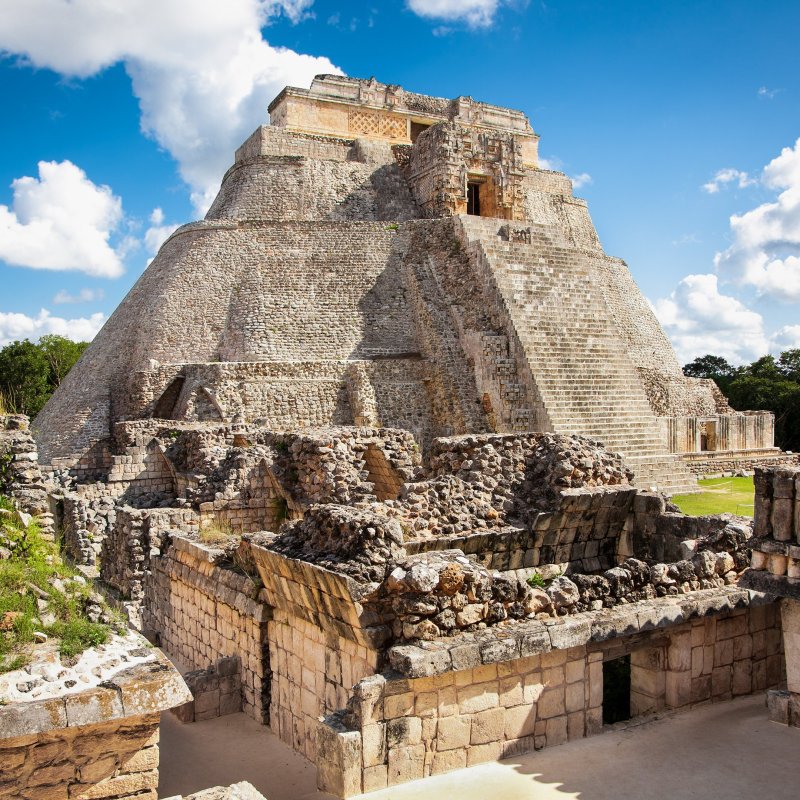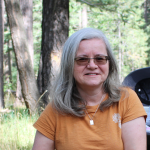
Everyone who visits or has plans to visit the Maya Riviera in the Yucatan knows about Chichen Itza. Being a World Heritage Site and home to the Pyramid of Kukulcan, one of the New Seven Wonders of the World, this is no surprise.
Videos by TravelAwaits
Dominating the center of the site, the Pyramid of Kukulcan alone is worth the visit. Four identical stairways lead to the top, with the number of steps adding up to the number of days in a solar year (364+1 step leading to the temple on top).

Jeff Fromm
Serpents, representations of the Maya God Kukulcan, adorn the stairways, and during the spring and fall equinoxes, the shadow of the great serpent seems to descend the stairs during sunset.
The famous pyramid is just the tip of the iceberg at this site. Chichen Itza is also home to the largest ball court in Mesoamerica, an ancient observatory, and a few other structures, including the Temple of the Warriors and the Mercado, that are worth visiting.
But because of all this, it is also one of the most visited and most crowded Maya archaeological sites. To protect it, you can’t get too close to any of the structures.
The good news is, the peninsula features many more Maya sites, where you can touch and even climb pyramids. Those who would rather not fight the crowds in Chichen Itza or want to explore structures they can get close to have plenty of alternatives. The following sites are just a few of them.

Emese Fromm
Coba
One of the largest and best-known Maya sites on the Yucatan Peninsula, the ruins of Coba in the state of Quintana Roo get plenty of visitors, but never feel as crowded as Chichen Itza. Part of the reason is the size and setting of the ruins.
Spreading over 30 square miles in a dense jungle off the main tourist road, the site can accommodate large numbers of visitors without feeling overcrowded. The ancient city is not so much one site, but a large group of multiple clusters of buildings centered around the main pyramid, Nohoch Mul.
Thousands visit the site to climb its famous pyramid at the end of a long trail through the jungle, but those who get there early enough can still be alone on its top, overlooking the rest of the site and the jungle canopy that covers most of it. The stairs are eroded, so climbing it is a bit dangerous, and strenuous (it has 130 steps) — so not for everyone — but a rope in the center helps, and with plenty of stops for rest, most people can handle it.

Other groups of structures in the archeological zone include the Coba Group, which features a pyramid called La Iglesia and a ballcourt; the Conjuncto Las Pinturas, which features a small pyramid with vivid paint still visible inside the temple from a certain angle (climbing this pyramid is not allowed); and the Macanxoc Group, with some of the most elaborate stelae (Maya writing and images on large stone slabs) of the Maya world.
While the trails between the structures are long, those who can’t walk that far or prefer to get there faster can rent bicycles or hire a “Maya taxi,” bicycles (operated by Maya locals) with two seats on the front for site visitors.

Emese Fromm
Uxmal
A UNESCO Heritage Site, Uxmal is one of the largest Maya sites in the state of Yucatan. Its main pyramid, the Pyramid of the Magician, dominates the site. According to legend, a dwarf magician, hatched from an egg, built it in one night. It is a great story, but in fact, the pyramid seen today was built on top of an older one, which was on top of an even older one, going back to five distinctive structures layered on top of each other. The result is one of the most impressive pyramids on the Yucatan. As spectacular as it is though, it is not the only building Uxmal is worth visiting for.
Built in the distinctive Puuc style, the city comprises ornate buildings adorned with carvings of serpents, elaborate latticework, and masks of the Maya rain god Chak. Two of the best examples that really stand out are the Palace of the Governors and the Nunnery Quadrangle. Both feature Chak masks, serpents, elaborate latticework, and columns.

Though the Pyramid of the Magician is closed to climbing, visitors need not leave without getting on top of a large pyramid. The Great Pyramid has a good reconstructed stairway that makes climbing relatively easy and offers a panoramic view of the site from its top.
Though Uxmal is on the tourist track and gets crowded occasionally, it’s large enough to give any visitor a chance to be alone with the ruins.

Ek Balam
A compact site, Ek Balam is the spectacular home to the largest (though not tallest) Maya structure in Yucatan: its Acropolis. Excavations here started in 1997, so it is a relatively new-to-visitors site and features some of the most ornate motifs and statues found on the peninsula to date. The Acropolis adorned by these statues is open to climbing, allowing visitors to get close to them. The stairway is safe and sturdy and allows visitors to rest along the climb, admiring the statues and bas-reliefs. The highlight of the structure is halfway up the stairs, where a monster-like figure — the black jaguar that gave the site its name — guards the entrance to the Underworld. Its walls are decorated with some of the most impressive statues and carvings.

Jeff Fromm
Stopping here is always a great respite from the Yucatecan sun, too, as you’ll be protected by a thatched roof. Those who make it to the top are rewarded for their efforts by a great panoramic view of the site and the surrounding jungle.
Other structures at the site include three palaces, a ball court, and the ancient entrance gate. Walking through the ruins is an easy stroll, and most of the path is shaded by mature trees.

Emese Fromm
Muyil
Though in ancient times Muyil, also known as Chunyaxche, was one of the most densely populated towns on the coast of the Yucatan Peninsula, it is a smaller site, hidden in the jungle. Since it sits in the northwest boundaries of the Si’an Ka’an Biosphere Reserve, visiting the archaeological site also includes walking through a dense, protected jungle. The site’s largest reconstructed structure is the Castillo. Standing at 57 feet tall, it is the highest building on the coast. Though reconstructed (in 1998), the stairway is still not safe, so it is closed to climbing, but it is spectacular. On the east side of the pyramid, a replica of an original bas-relief sculpture of herons is visible close to the top. A few other structures, including smaller pyramids and a cave, are also worth a stop. The path through it all is well-maintained gravel and is flat, making it a pleasant, easy stroll for visitors, regardless of fitness level.

Don’t leave the archaeological site without a walk through the Si’an Ka’an Reserve, though. A path starting behind the Castillo leads to a small wooden hut, where for a modest fee you can enter the preserve and walk out to the lagoon. This trail, on a raised boardwalk, might be the highlight of your visit. Surrounded by dense jungle, walking above freshwater boiled up from cenotes, if you are quiet, you’ll likely encounter wildlife.

Jeff Fromm
Mayapan
One of the last great Maya capitals before the Spanish arrived on the peninsula, Mayapan is like a smaller copy of Chichen Itza. In fact, its main building is an almost identical replica of the Pyramid of Kukulcan. Other than its size, the main difference is that visitors can climb this one and get a great view of the whole site.
Speaking of getting close to the structures, the Temple of the Painted Niches is open to walk through and you can enjoy the still-vivid colors of its murals, similar to those found in the central parts of Mexico. In fact, the murals are the only elements that differ from Chichen Itza. The Observatories, cylindrical buildings that are replicas of the Observatory of Chichen Itza, had the same astronomical use: tracking the planets. Carvings inside the Main Observatory show the tracking of the positions of Venus.

The ceremonial center on the west edge of the site comprises the most important structures, including the residences of the noble class, and administrative, religious, and government buildings. Temples, shrines, and altars are some other highlights of the site.
Though a relatively large site, Mayapan is easy to walk through, and the structures are not too high to climb. Off the tourist track, few people know about it and even fewer visit it, so chances are you will only encounter a handful of others, or might even find yourself alone with the ancient stones.

Tips For A Pleasant Maya Ruin Visit
When visiting any of the Maya ruins on the Yucatan Peninsula, make sure you have sun protection, sunscreen, and a hat, and wear lightweight clothes and comfortable walking shoes. Bug spray also goes a long way, especially in the wet season (winter months in the Northern Hemisphere). Don’t forget a water bottle.
To visit most of the above-mentioned sites, it is best to rent a car and drive to them, though public transportation is available for them, and some are part of tours from Tulum or Cancun. When driving on the peninsula, watch out for topez, or speed bumps, one on each end of any town or village. Just about everyone on the peninsula speaks English, especially the younger generation, but it might still be nice to understand and speak a few words of Spanish (or even Maya). Above all, bring your sense of adventure, and remember to have fun.
Also, why Maya and not Mayan? Scholars only use the adjective Mayan when referring to the family of Mayan languages (over 20 are still spoken), but simply use Maya for everything else, even as an adjective, including Maya civilization, Maya archaeology, and Maya ruins.
Still want to see the most famous ruins on the Yucatan? Here are seven tips for visiting Chichen Itza.
